Set off on a sacred voyage to discover the ten most sanctified places of worship in Vadodara, Gujarat. The temples of Vadodara provide splendor in their architecture and hallowed narratives, embodying peace and mystery. Ranging from the distinctive EME Temple to the venerable Kuber Bhandari, these sanctuaries offer tranquil encounters amid colorful celebrations and holy aartis, echoing the vibrant cultural fabric of Gujarat.
Top 10 Famous Temples in Vadodara, Gujarat
1. Dhundiraj Ganpati Temple: 2 km from Vadodara

Vadodara, a cultural hub in Gujarat, boasts numerous sacred temples, each showcasing spirituality and architectural grandeur. Among them, Dhundiraj Ganpati Temple, just 2 km from the city center, stands as a beacon of devotion. Built in 1844 by Gopalrao Mairal, this double-story temple reflects the Maratha dynasty’s reverence for Lord Ganesha. Visitors are mesmerized by its vibrant colors and intricate floral motifs, making it a must-visit tourist attraction.
- Architectural Splendor: The temple showcases the skilled craftsmanship of the Maratha period.
- Historical Significance: It symbolizes the Maratha influence in the region and their devotion to Lord Ganesha.
- Cultural Experience: A visit offers insight into the Maratha clan’s religious practices.
- Spiritual Atmosphere: The serene environment provides a meditative experience.
- Accessibility: Its proximity to Vadodara makes it an effortless destination for travelers.
- Cons: Limited information about temple timings; may be crowded during festivals.
2. Kirti Mandir: 2.5 km from Vadodara

Kirti Mandir, just 2.5 km from Vadodara’s city center, embodies the city’s regal history and architectural beauty. Built in 1936 by Maharaja Sayajirao Gaekwad III, this memorial for the Gaekwads features an imposing structure with a bronze Sun, Moon, and a map of undivided India at its pinnacle. As a notable attraction, it reflects the Gaekwad legacy and offers a serene ambience.
- Architectural Prowess: The mandir showcases Indo-Saracenic design elements, interlaced with Western, Mughal, and Maratha architectural motifs.
- Cultural Connectivity: It stands as a memory keeper of the city’s royal lineage and history, attracting cultural enthusiasts.
- Artistic Exhibits: The interior mural paintings by renowned artist Nandalal Bose are a visual feast.
- Symbolic Significance: The temple embodies unity and the rich legacy of the Gaekwad rule.
- Serene Vicinity: Despite its location near the city, the temple provides a tranquil retreat.
- Cons: Photography might be restricted inside the main hall; specific sections may require maintenance.
- Recommended for: History buffs, architecture aficionados, and those seeking to understand Vadodara’s cultural roots.
3. Shri Surya Narayan Temple: 4 km from Vadodara
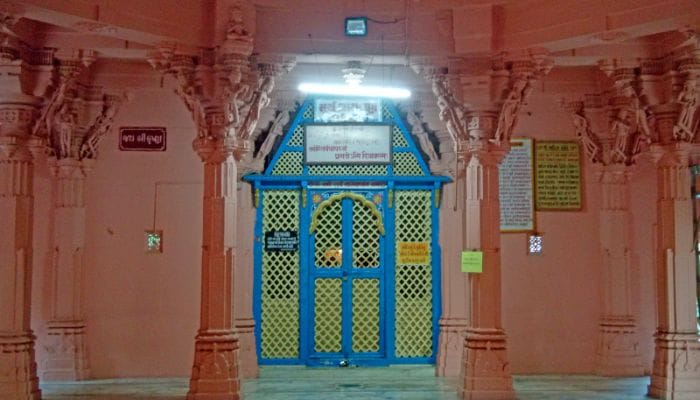 Image Source
Image SourcePositioned 4 km from Vadodara’s heart, Shri Surya Narayan Temple in Atladara beams with divine radiance. One of the few temples in Gujarat dedicated to Lord Surya, it offers a unique worship experience. The temple’s iconic chariot-shaped architecture, with seven horses symbolizing the days of the week, captivates devotees and art enthusiasts. With a prominent statue, nearby stalls, and serene darshan, it stands as a bright spot in Gujarat’s spiritual landscape.
- Unique Deity: The temple is among the rare shrines dedicated to Lord Surya in Gujarat.
- Architectural Marvel: With a chariot design complete with seven horses, the temple is an artistic spectacle.
- Symbolic Space: Represents the power of the sun and its spiritual significance in Hinduism.
- Auspicious Visits: Believed to grant relief from planetary doshas, especially those pertaining to the sun.
- Peaceful Environment: Offers a contemplative environment away from the city’s hustle.
- Cons: May not be as expansive as other temples; limited shade available outside.
- Ideal for: Astrology enthusiasts, spiritual individuals seeking blessings, and art lovers moved by unique architectural designs.
4. EME Temple: 6 km from Vadodara
 Image Source
Image SourceLocated 6 km from Vadodara, the EME Temple or Dakshinamurty Temple is a unique architectural marvel with a geodesic structure clad in aluminum. Established in 1966 and managed by the Indian Army, it welcomes all faiths. Nearby, the ISKCON Temple adds to the spiritual appeal. Celebrating its Diamond Jubilee, the temple features well-maintained washrooms and beautiful sculptures, earning positive EME Temple reviews for its tranquil ambiance tourists. Moreover, the EME Temple prides itself on fostering unity, as it welcomes people of all faiths to experience its tranquil ambiance and spiritual allure.
- Modern Design: The temple’s geodesic dome is a departure from conventional temple structures, intriguing architecture buffs.
- Army Maintenance: Its upkeep by the Indian Army ensures the temple’s pristine condition, reflecting discipline and order.
- Cultural Harmony: The temple’s inclusive philosophy is a beacon for communal peace and harmony.
- Museum Collection: The temple complex houses an impressive collection of historical and religious artefacts.
- Landscaped Grounds: The immaculate gardens provide a serene environment for meditation and relaxation.
- Cons: Photography might be restricted in certain areas; visitors must adhere to the decorum set by army guidelines.
- Recommended for: Military history enthusiasts, those drawn to nontraditional spiritual sites, and advocates of unity across diverse cultures.
5. Kashi Vishwanath Mahadev Temple: 7 km from Vadodara
 Image Source
Image SourceThe Kashi Vishwanath Mahadev Temple, about 7 km from Vadodara, is a divine sanctuary dedicated to Lord Shiva, mirroring the famed Varanasi temple. This spiritual edifice attracts devotees seeking sanctity and peace. The temple’s serene surroundings and ethereal atmosphere, with prayer chants and incense, offer solace and a rich tapestry of traditional Poojas and Aaratis. Its unique infrastructure and architectural marvels make it a speciality of the Baroda State, located along a tranquil lane.
- Spiritual Resemblance: Resonates with the aura of the original Kashi Vishwanath Temple, offering a semblance of the spiritual journey to the holy city of Varanasi.
- Divine Ceremonies: The temple is well-known for its fervent celebrations of festivals and daily rituals that heighten the spiritual ambiance.
- Serene Setting: Ensconced in tranquility, the temple is a retreat for meditation and reflection.
- Cultural Significance: Engages visitors with the timeless practices and stories of Hinduism centered around Lord Shiva.
- Reverential Atmosphere: A place where the sacred synergy of tangible faith can be witnessed and felt.
- Cons: It might be challenging to navigate during peak festival times due to large crowds; limited parking space.
- Ideal for: Pilgrims desiring the holy experience of Kashi, seekers of spirituality, and those interested in Hindu worship rituals.
6. Shree Aksharpurushottam Swaminarayan Temple: 8 km from Vadodara
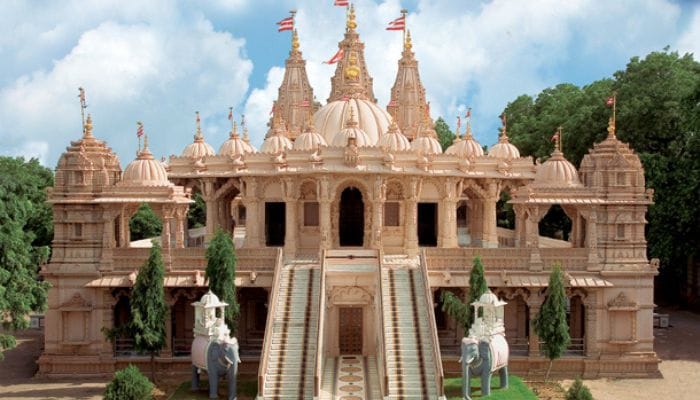 Image Source
Image SourceThe divine expanse of Shree Aksharpurushottam Swaminarayan BAPS Mandir, 8 km from Vadodara, radiates spiritual grandeur and architectural finesse. This serene and intricately crafted temple offers a tranquil atmosphere for meditation and serves as a community hub. Although it can be crowded during special events, it remains a welcoming space for all, reflecting the rich cultural traditions of the Swaminarayan sect.
- Architectural Artistry: The temple is a masterpiece of marble and wood, showcasing the intricate designs that exemplify supreme skill.
- Calmful Haven: It provides a tranquil atmosphere conducive to meditation and introspection.
- Cultural Richness: Reflects the traditions of the Swaminarayan sect and offers insights into their spiritual philosophies.
- Community Hub: Acts as a congregation point for social and religious activities, strengthening community bonds.
- Inclusive Spirit: Invites people from all walks of life to experience the sublime beauty and peaceful environment.
- Cons: As a popular site, it can be crowded during special events and weekends, which might affect the quietude some visitors seek.
- Recommended for: Devotees of Swaminarayan faith, admirers of temple architecture, and anyone interested in experiencing the bliss of a sacred space.
7. Tapovan Mandir: 12 km from Vadodara
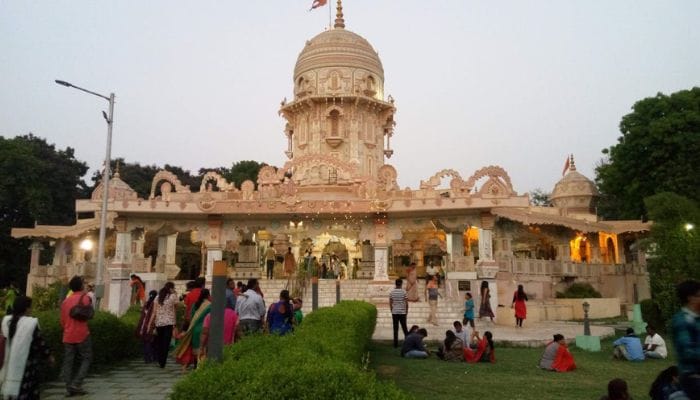 Image Source
Image SourceShree Tapovan Temple, located 12 km from Vadodara, offers a spiritual oasis in the Petrochemical Township. This temple, dedicated to Lord Shiva and various deities, embodies tranquility and spiritual solace. Its striking architecture, intricate carvings, and serene worship hall create an atmosphere of reflection and reverence. Surrounded by lush greenery, the temple also features a Gaushala and a meditation hall, enhancing its serene charm. Recognized for its excellence in aesthetics, Shree Tapovan Temple is a peaceful retreat and a delightful picnic spot.
- Architectural Appeal: Integrating traditional design with spellbinding artwork that graces its walls.
- Diverse Deities: A multi-deity temple, providing a holistic spiritual experience for visitors.
- Meditative Space: Offering a meditation hall that helps soothe the mind and invite introspection.
- Natural Setting: Surrounded by a green belt, enhancing the spiritual journey with nature’s serenity.
- Cultural Significance: Preserves and celebrates the tapestry of Hindu worship practices and festivals.
- Cons: The location might require additional travel for visitors not residing within the Petrochemical Township; specific areas could be busy during peak hours.
- Ideal for: Meditation enthusiasts, nature lovers, and anyone interested in exploring the diverse manifestations of the divine in Hinduism.
8. Kuber Bhandari Shiva Temple: 15 km from Vadodara
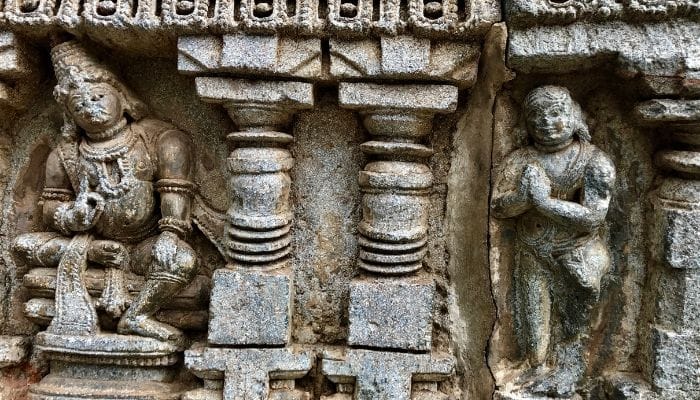 Image Source
Image SourceThe Kuber Bhandari Shiva Temple, 15 km from Vadodara, is a revered site situated 800 feet above sea level. Devotees climb 680 steps to reach this ancient, 2500-year-old temple, offering breathtaking views of the River Mahi and surrounding landscapes. The temple’s legend speaks of Lord Shiva transforming into sustenance for Parvati, earning the name Kuber Bhandari, the divine provider of food and water. Its proximity to the sacred Narmada River enhances its spiritual allure, attracting many pilgrims, especially on Amavasya. The serene temple premises make it a significant site for spiritual reflection.
- Serene Location: Perched atop a hill, the temple offers panoramic vistas and an atmosphere of peacefulness.
- Mythological Essence: Steeped in mythological tales, offering spiritual enrichment through storied history.
- Ancient Origins: Renowned for its antiquity, the temple invites those fascinated by India’s age-old religious practices.
- Pilgrim’s Journey: The climb to the temple is considered an act of devotion and requires a moderate level of fitness.
- River’s Proximity: Its nearness to the Narmada River invokes a deeper spiritual connection to nature and the cosmos.
- Cons: The strenuous climb may be challenging for some; basic amenities may be limited due to its remote hilltop location.
- Recommended for: Pilgrims, adventure seekers, and history enthusiasts wanting to experience spirituality enveloped within nature’s embrace.
9. Nilkanth Dham Swaminarayan Temple: 20 km from Vadodara
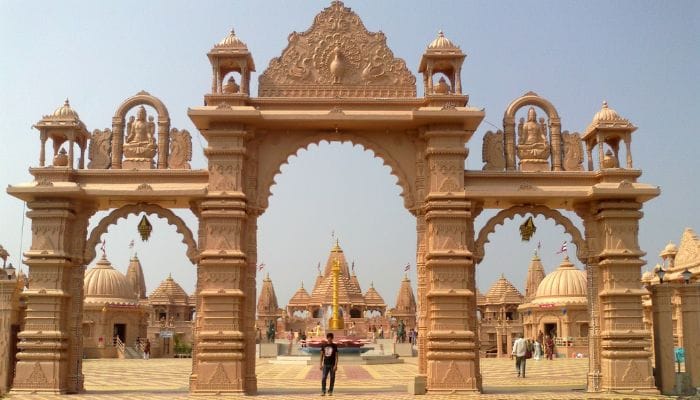 Image Source
Image SourceSituated 20 km from Vadodara, Nilkanth Dham Swaminarayan Temple in Poicha is a majestic pilgrimage site on the banks of the Narmada River. Inaugurated in 2013, this BAPS Shri Swaminarayan Temple is a marvel of modern Indian architecture and spirituality. Visitors are captivated by intricately carved pillars, awe-inspiring deities, and the spectacular evening Aarti featuring colossal elephants pulling a giant bell. The temple complex includes a Navgraha Temple, a Haveli, and the Sahajanand Universe, a cultural amusement park that blends tradition with technology, enlightening visitors on Hindu mythology and values.
- Architectural Grandeur: Features impressive craftsmanship and state-of-the-art thematic displays.
- Cultural Immersion: The Sahajanand Universe renders an educational and interactive exploration of Hindu epics and morals.
- Spiritual Majesty: The evening Aarti is particularly notable for its grandeur and spiritual vibrancy.
- Scenic Environs: The temple, set against the backdrop of the serene Narmada, offers a picturesque landscape.
- Technological Interplay: Utilizes modern technology for cultural exhibitions, making it appealing to younger generations.
- Cons: Its popularity may result in crowded experiences during peak times; transportation scheduling is crucial for reaching the remote location. -Practice mindfulness and respect each site’s norms and culture to ensure a harmonious visit.
- Ideal for: Families, technophiles looking for a unique spiritual experience, and traditionalists seeking to witness the splendor of contemporary temple architecture.
10. Kayavarohan Temple: 32 km from Vadodara
 Image Source
Image SourceResting 32 km from Vadodara, the Kayavarohan Temple is a site of historical and spiritual significance. Regarded as one of the 68 teerthas and pivotal for the Pasupata sect followers of sage Lakulish, this temple has seen splendor and destruction, including being razed by Mahmud of Ghazni. Resurrected in the 20th century by Swami Kripaluanandji Maharaja, also known as Bapuji, the current temple stands as a testament to resilience and spiritual tradition. Within its bounds, it showcases an exquisitely carved Shiva lingam.
- Historical Legacy: The site’s archaeological and historical significance attracts those interested in India’s ancient past.
- Cultural Relevance: Considered a stronghold of the Pasupata sect, providing deep insights into esoteric Shaivism.
- Resilient Heritage: A symbol of cultural endurance, showing the temple’s capacity to revive through restoration efforts.
- Divine Idol: Highlights a unique and sacred Shiva lingam known to bestow blessings upon its worshippers.
- Peaceful Ambiance: Despite its rich history, the temple offers a tranquil environment for contemplation and worship.
- Cons: Being off the beaten path, it may require special travel arrangements; the remnants of its tumultuous history may affect some visitors emotionally.
- Recommended for: Those captivated by India’s rich spiritual heritage, architectural buffs, and followers of Lord Shiva seeking blessings and enlightenment.
Enriching Your Visit: Travel Tips and Must-Knows
Best Time to Visit and Cultural Festivities
The ideal time to visit Vadodara’s temples is from October to March, when the weather is cool and festivals like Navratri, Diwali, and Janmashtami are in full swing. These celebrations infuse the temples with vibrant energy, offering a chance to engage with local traditions. Visitors can enjoy elaborate decorations, community prayers, and special cultural programs. However, travelers should plan ahead to manage the increased crowds and heightened security during these festive periods.
Best Time to Visit Vadodara’s Temples: Weather, Festivals, and Highlights
| Time Period | Weather | Festivals | Highlights |
| October to March | Cool and pleasant | Navratri, Diwali, Janmashtami | Vibrant energy, elaborate decorations, community prayers, cultural programs |
Easing Your Way Around: Transportation Options
Vadodara’s transportation options, including buses, auto-rickshaws, taxis, and ride-sharing services, make temple visits convenient. Auto-rickshaws are perfect for short trips, while taxis offer comfort for families. Car rentals provide independence, and bicycles offer an eco-friendly way to explore. Custom tour packages from travel agencies ensure a stress-free, enjoyable visit, tailored to your needs.
Explore the Best of Vadodara: Resorts, Restaurants, Temples, and More
Explore thrilling activities at various resorts near Vadodara that offer adventure sports and luxurious accommodations. Plan your exciting getaway by visiting resorts near Vadodara with adventure.
Savor authentic Gujarati cuisine at the best restaurants in Vadodara, where traditional flavors meet modern ambiance. Discover top dining spots at Gujarati restaurants in Vadodara.
Enjoy a refreshing break with a one-day picnic at the beautiful resorts near Vadodara, perfect for family and friends. Find the best options for a short retreat at resorts near Vadodara for one day picnic.
Find comfortable and safe accommodations for couples at the best couple-friendly hotels in Vadodara. Learn more about these welcoming stays.
Indulge in a culinary journey at the top restaurants in Vadodara, offering a variety of delicious cuisines. Discover your next favorite dining spot at restaurants in Vadodara.
Plan a fun-filled day out at the best places near Vadodara for picnic, perfect for families and friends. Explore these scenic locations.
Enjoy a cozy and intimate coffee date at the best cafes in Vadodara, specially curated for couples. Find the perfect cafe for your next outing at best cafes in Vadodara for couples.
Experience top-notch hospitality at the best hotels in Vadodara, offering comfort and luxury. Book your stay now.
Immerse yourself in the rich history and culture of the city by visiting the top museums in Vadodara. Plan your cultural tour today.
Embrace the great outdoors with exciting camping near Vadodara, perfect for adventure enthusiasts. Find the best camping spots.
Discover the top attractions and places to visit in Vadodara to make your trip memorable. Get a comprehensive guide.
Explore the spiritual heritage of Gujarat through its renowned temples, like Somnath and Dwarkadhish. For more details, visit our guide on famous temples in Gujarat to delve deeper into these sacred sites.
Frequently Asked Questions About Temples in Vadodara
What are the must-visit temples in Vadodara for first-time travelers?
For first-time travelers to Vadodara, the must-visit temples include the Kirti Mandir for its architectural grandeur and historical import, EME Temple for its modernistic design and inter-faith openness, and the ancient Kuber Bhandari Shiva Temple for its picturesque hilltop location and historical significance. Each temple offers a unique glimpse into the spiritual heart and cultural richness of Vadodara.
Which is the oldest temple in Vadodara?
The oldest temple in Vadodara is the Kuber Bhandari Shiva Temple, believed to be 2500 years old. Nestled atop a hill near the Narmada River, it is not only an ancient spiritual site but also a place of extraordinary historical and mythological significance in the region.
Which is the most important part of a temple?
The most important part of a temple is the garbhagriha or the sanctum sanctorum. It is the innermost chamber where the main idol or deity of the temple is enshrined. Here, priests perform religious rituals, and devotees offer their worship and prayers directly to the deity, making it the spiritual epicenter of the temple.
How to reach EME temple Vadodara?
To reach the EME Temple in Vadodara, one can hire a taxi, auto-rickshaw, or take a city bus that travels toward Fatehgunj or Makarpura. The temple is also accessible via ride-sharing services like Ola and Uber for direct and convenient transit. It lies approximately 6 km from the Vadodara Railway Station and is well-connected by city roads.
Final Remarks
In Vadodara, each temple tells a unique story, creating a mosaic of culture, faith, and history. From the heritage-rich Kirti Mandir to the modern EME Temple, these sites offer spiritual experiences against Gujarat’s vibrant traditions and landscapes. Nearby attractions include Champaner-Pavagadh Archaeological Park, BAPS Shri Swaminarayan Mandir, and temples in Surat, Ahmedabad, Chanod, and Tirupati Balaji. The architectural beauty, elaborate festivities, and moments of reflection at Vadodara’s temples promise a journey that reflects past glory and present liveliness. Plan your visit to embrace the cultural wealth of this historic city.



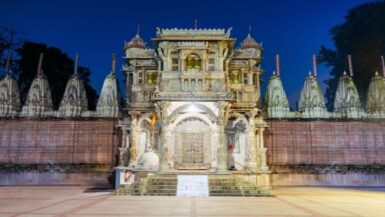

GameAthlon is a leading online casino offering dynamic gameplay for users of all levels.
The site provides a diverse collection of slot games, live dealer games, table games, and sportsbook.
Players have access to smooth navigation, top-notch visuals, and intuitive interfaces on both computer and tablets.
http://www.gameathlon.gr
GameAthlon takes care of security by offering trusted payment methods and fair RNG systems.
Promotions and loyalty programs are constantly improved, giving members extra opportunities to win and enjoy the game.
The support service is on hand around the clock, helping with any inquiries quickly and efficiently.
The site is the top destination for those looking for fun and huge prizes in one safe space.
GameAthlon is a popular entertainment platform offering thrilling casino experiences for players of all levels.
The platform provides a extensive collection of slots, live dealer games, card games, and betting options.
Players have access to fast navigation, top-notch visuals, and intuitive interfaces on both PC and smartphones.
http://www.gameathlon.gr
GameAthlon prioritizes security by offering encrypted transactions and transparent outcomes.
Reward programs and special rewards are frequently refreshed, giving registered users extra incentives to win and have fun.
The support service is available around the clock, supporting with any issues quickly and professionally.
The site is the perfect place for those looking for an adrenaline rush and huge prizes in one trusted space.
Предоставляем услуги проката автобусов и микроавтобусов с водителем для крупных корпораций, малым и средним предприятиям, а также частным лицам.
https://avtoaibolit-76.ru/
Гарантируем максимально комфортную и надежную поездку для коллективов, организуя заказы на свадьбы, корпоративные встречи, экскурсии и другие мероприятия в городе Челябинске и Челябинской области.
Мы предлагаем услуги проката автобусов и микроавтобусов с водителем корпоративным клиентам, бизнеса любого масштаба, а также частным лицам.
Обслуживание корпоративных мероприятий
Организуем приятную и надежную доставку небольших и больших групп, организуя поездки на торжества, корпоративы, групповые экскурсии и все типы мероприятий в Челябинске и Челябинской области.
Exquisite wristwatches have long been synonymous with precision. Meticulously designed by world-class brands, they combine tradition with innovation.
Each detail reflect unmatched attention to detail, from intricate mechanisms to high-end elements.
Wearing a Swiss watch is not just about telling time. It stands for timeless elegance and exceptional durability.
Whether you prefer a bold statement piece, Swiss watches deliver unparalleled reliability that stands the test of time.
https://forums.shadowruntabletop.com/index.php/topic,34761.new.html#new
Our store provides a vast selection of trusted medicines for various needs.
Our online pharmacy ensures quick and reliable order processing right to your door.
Every item is supplied by certified manufacturers so you get authenticity and compliance.
You can explore our selection and place your order in minutes.
Need help? Customer service are here to help 24/7.
Prioritize your well-being with our trusted online pharmacy!
https://www.storeboard.com/blogs/health/how-erectafil-100-mg-helped-me-reclaim-my-confidence-on-and-off-the-field/6074681
Сертификация в нашей стране является неотъемлемым условием выхода продукции на рынок.
Система сертификации подтверждает полное соответствие техническим регламентам и официальным требованиям, что, в свою очередь, гарантирует защиту покупателей от некачественных товаров.
оформление сертификатов
К тому же, официальное подтверждение качества облегчает деловые отношения с крупными ритейлерами и открывает возможности на рынке.
Без сертификации, не исключены штрафы и ограничения при продаже товаров.
Таким образом, получение сертификатов не просто формальностью, но и важным фактором устойчивого роста организации на отечественном рынке.
Прохождение сертификации на территории РФ является ключевым этапом выхода продукции на рынок.
Процедура подтверждения качества гарантирует соответствие установленным требованиям государственным стандартам и правилам, что защищает потребителей от некачественных товаров.
добровольная сертификация
Кроме того, наличие сертификатов способствует сотрудничество с партнерами и расширяет перспективы на рынке.
Без сертификации, не исключены штрафы и ограничения при продаже товаров.
Поэтому, оформление документации не просто формальностью, но и важным фактором устойчивого роста компании на отечественном рынке.
Regardless of the widespread use of digital timepieces, traditional timepieces remain iconic.
A lot of enthusiasts value the intricate design that defines classic automatics.
In contrast to smartwatches, that become outdated, classic timepieces remain prestigious over time.
https://1fckyjov-staripani.cz/index.php/forum/soupisky/128#499340
High-end manufacturers are always introducing limited-edition traditional watches, proving that demand for them remains strong.
For many, a mechanical watch is not just an accessory, but a tribute to craftsmanship.
While smartwatches come with modern tech, mechanical watches represent an art form that remains unmatched.
Чем интересен BlackSprut?
Сервис BlackSprut удостаивается интерес разных сообществ. Что делает его уникальным?
Эта площадка обеспечивает широкие возможности для своих пользователей. Оформление платформы характеризуется простотой, что делает его доступной даже для тех, кто впервые сталкивается с подобными сервисами.
Важно отметить, что этот ресурс обладает уникальными характеристиками, которые отличают его в определенной среде.
Говоря о BlackSprut, стоит отметить, что определенная аудитория оценивают его по-разному. Многие подчеркивают его удобство, другие же рассматривают более критично.
В целом, данный сервис остается предметом обсуждений и вызывает интерес разных пользователей.
Ищете рабочее зеркало BlackSprut?
Если ищете обновленный домен BlackSprut, то вы по адресу.
bs2best at сайт
Иногда ресурс перемещается, и тогда нужно знать актуальное зеркало.
Обновленный адрес легко найти здесь.
Посмотрите актуальную версию сайта прямо сейчас!
Buying medications on the internet has become far easier than visiting a local drugstore.
You don’t have to deal with crowds or worry about limited availability.
E-pharmacies allow you to get prescription drugs with just a few clicks.
A lot of digital pharmacies offer discounts compared to physical stores.
https://todayssolutionrelationships.com/is-an-invisible-thread-the-secret-to-long-distance-love/#comment-11471
Additionally, it’s possible to browse different brands without hassle.
Fast shipping adds to the ease.
What do you think about ordering from e-pharmacies?
Фанаты слотов всегда найдут зеркальное альтернативный адрес онлайн-казино Champion и наслаждаться любым игровым ассортиментом.
На сайте можно найти разнообразные игровые автоматы, от ретро-автоматов до современных, а также новейшие игры от ведущих производителей.
Когда основной портал оказался недоступен, альтернативная ссылка поможет без проблем войти и делать ставки без перебоев.
https://casino-champions-slots.ru
Все возможности полностью работают, включая регистрацию, финансовые операции, и акции для игроков.
Пользуйтесь проверенную альтернативный адрес, и не терять доступ к казино Чемпион!
Почему BlackSprut привлекает внимание?
Сервис BlackSprut привлекает внимание многих пользователей. В чем его особенности?
Эта площадка предоставляет широкие функции для своих пользователей. Интерфейс сайта выделяется простотой, что делает его интуитивно удобной даже для новичков.
Необходимо помнить, что BlackSprut обладает уникальными характеристиками, которые отличают его в своей нише.
Говоря о BlackSprut, стоит отметить, что различные сообщества оценивают его по-разному. Некоторые подчеркивают его удобство, другие же относятся к нему более критично.
Подводя итоги, BlackSprut остается объектом интереса и вызывает заинтересованность разных слоев интернет-сообщества.
Ищете рабочее зеркало BlackSprut?
Хотите узнать свежее зеркало на БлэкСпрут? Это можно сделать здесь.
bs2best at сайт
Иногда платформа меняет адрес, и тогда приходится искать актуальное ссылку.
Обновленный доступ всегда можно найти здесь.
Проверьте рабочую ссылку у нас!
Our platform features a wide selection of online slots, designed for different gaming styles.
Right here, you can find traditional machines, new generation slots, and progressive jackpots with high-quality visuals and dynamic music.
If you are a fan of minimal mechanics or love complex features, you’re sure to find a perfect match.
https://dogovor-urist.ru/%D1%8E%D1%80%D0%B8%D0%B4%D0%B8%D1%87%D0%B5%D1%81%D0%BA%D0%B0%D1%8F_%D0%BA%D0%BE%D0%BD%D1%81%D1%83%D0%BB%D1%8C%D1%82%D0%B0%D1%86%D0%B8%D1%8F/22384-%D0%BF%D1%80%D0%B5%D0%B4%D0%BF%D0%BE%D1%87%D0%B8%D1%82%D0%B0%D0%B5%D1%82%D0%B5_%D1%81%D1%8B%D0%B3%D1%80%D0%B0%D1%82%D1%8C_%D0%B2_%D0%B8%D0%BD%D1%82%D0%B5%D1%80%D0%B5%D1%81%D0%BD%D1%8B%D0%B9_%D1%81%D0%BB%D0%BE%D1%82_sweet_bonanza/?m=q-added
Every slot is playable around the clock, right in your browser, and well adapted for both PC and mobile.
In addition to games, the site includes slot guides, welcome packages, and player feedback to enhance your experience.
Register today, jump into the action, and enjoy the excitement of spinning!
Here offers a wide selection of home timepieces for every room.
You can check out urban and vintage styles to complement your living space.
Each piece is carefully selected for its design quality and accuracy.
Whether you’re decorating a functional kitchen, there’s always a beautiful clock waiting for you.
la crosse alarm clocks
The shop is regularly updated with fresh designs.
We focus on quality packaging, so your order is always in professional processing.
Start your journey to timeless elegance with just a few clicks.
This website offers a diverse range of interior wall clocks for any space.
You can discover contemporary and classic styles to match your home.
Each piece is chosen for its design quality and durability.
Whether you’re decorating a stylish living room, there’s always a beautiful clock waiting for you.
best very 3d large wall clocks
Our assortment is regularly refreshed with fresh designs.
We care about quality packaging, so your order is always in safe hands.
Start your journey to better decor with just a few clicks.
Our platform offers a large assortment of interior wall-mounted clocks for any space.
You can explore minimalist and timeless styles to enhance your interior.
Each piece is carefully selected for its visual appeal and durability.
Whether you’re decorating a creative workspace, there’s always a fitting clock waiting for you.
best blue light alarm clocks
Our assortment is regularly updated with new arrivals.
We care about secure delivery, so your order is always in professional processing.
Start your journey to enhanced interiors with just a few clicks.
This online service provides various prescription drugs for online purchase.
Users can easily order treatments from your device.
Our range includes everyday drugs and specialty items.
The full range is sourced from licensed providers.
https://www.pinterest.com/pin/879609370963950817/
We maintain user protection, with encrypted transactions and prompt delivery.
Whether you’re looking for daily supplements, you’ll find safe products here.
Begin shopping today and get convenient support.